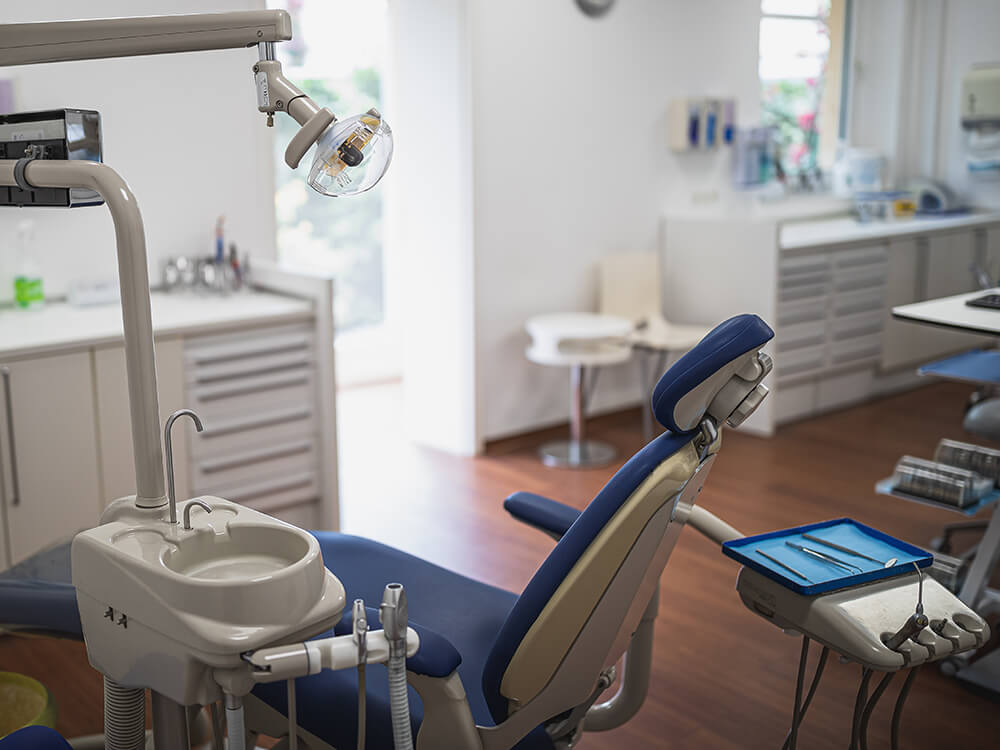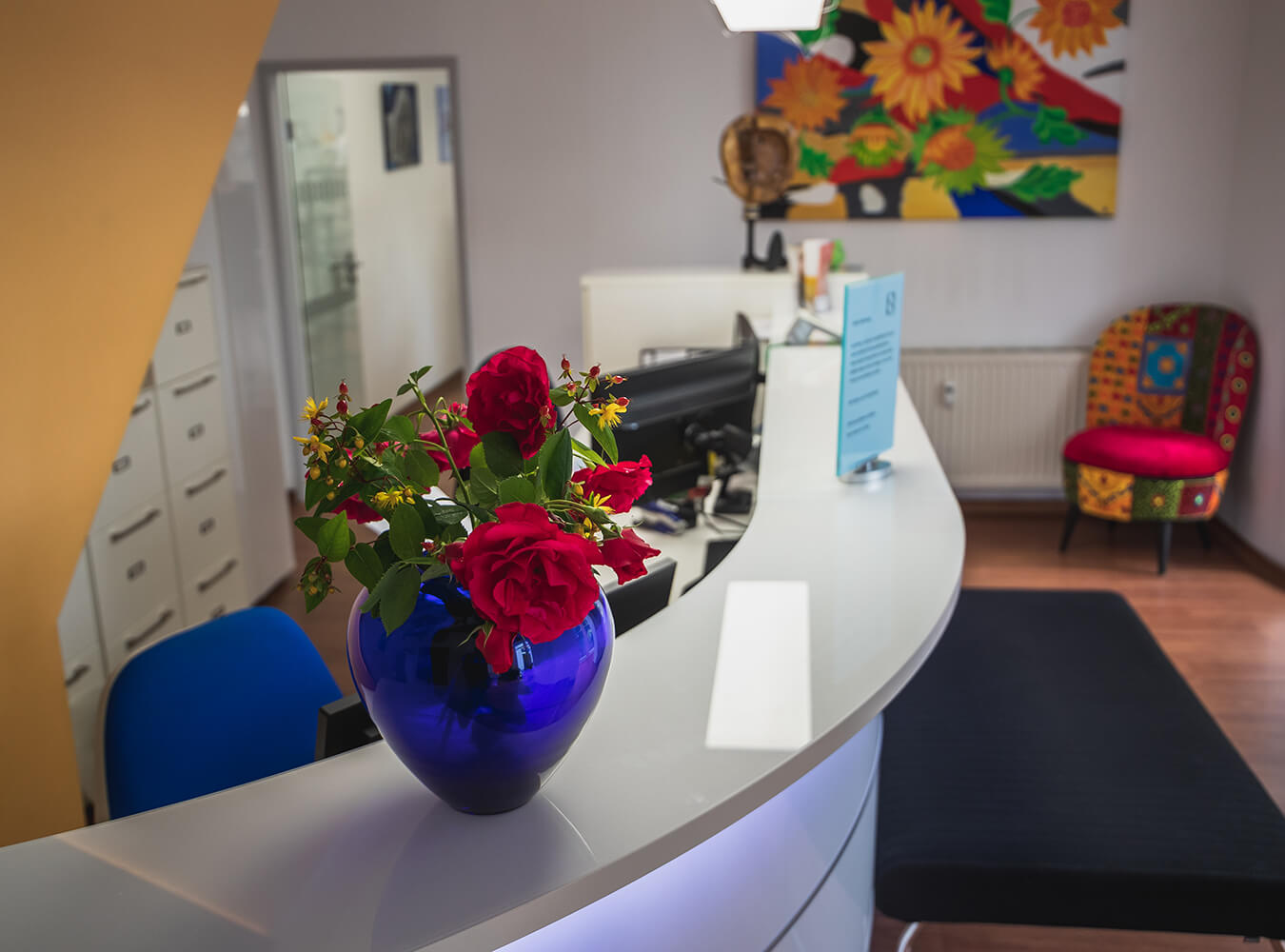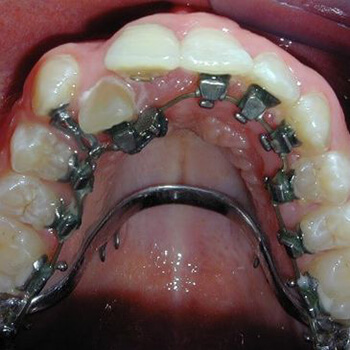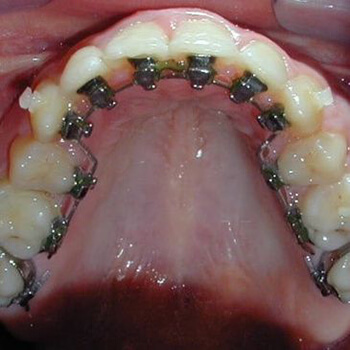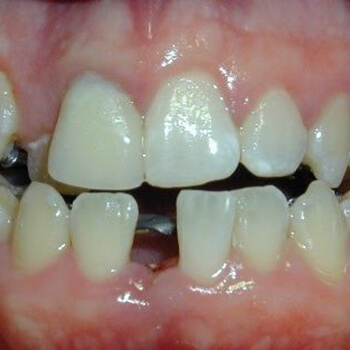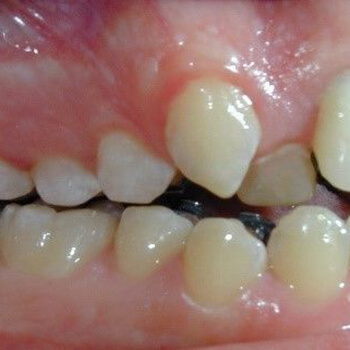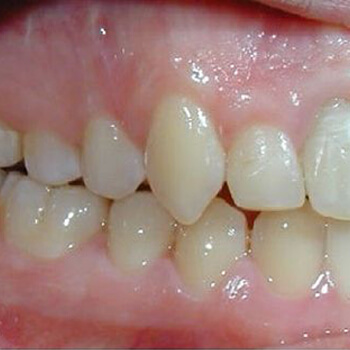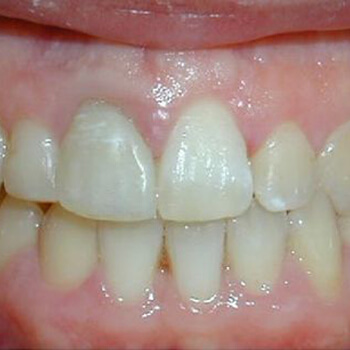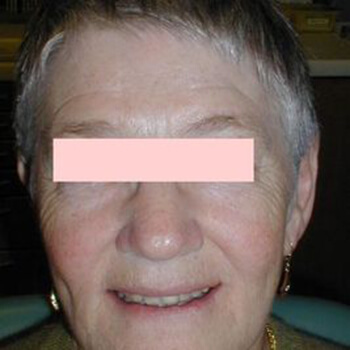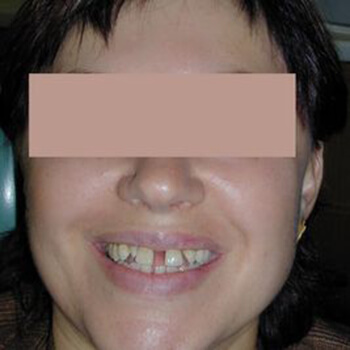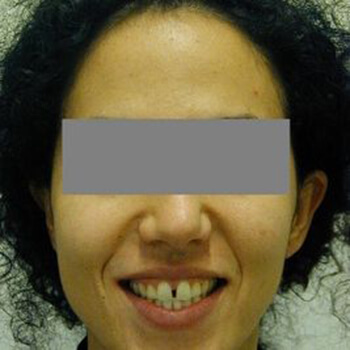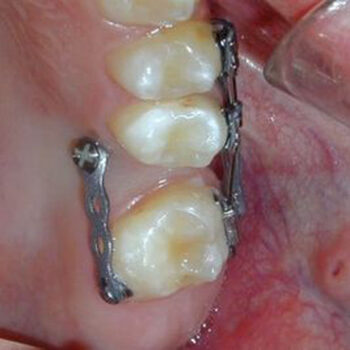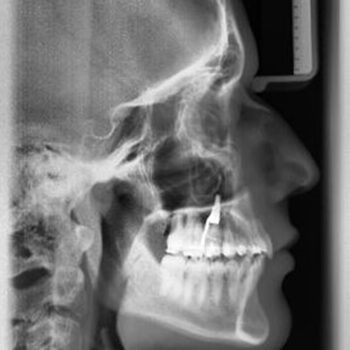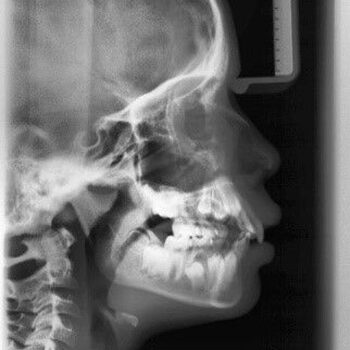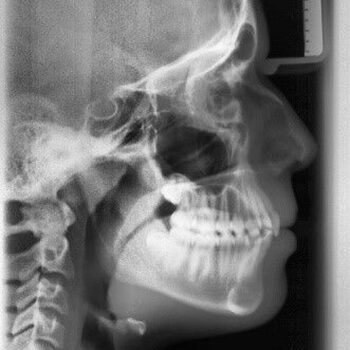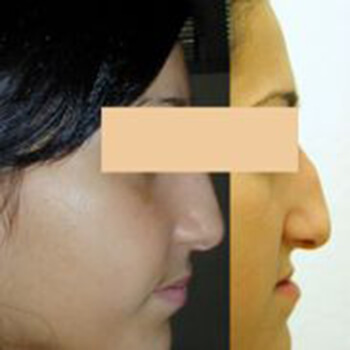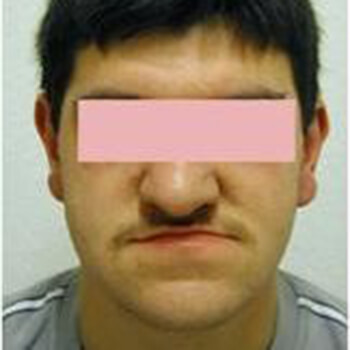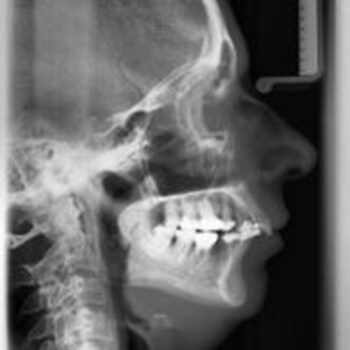We offer in our practice a wide range of treatments for misaligned teeth and jaws. Our range of treatments includes
Misaligned teeth
Gentle correction of crooked teeth
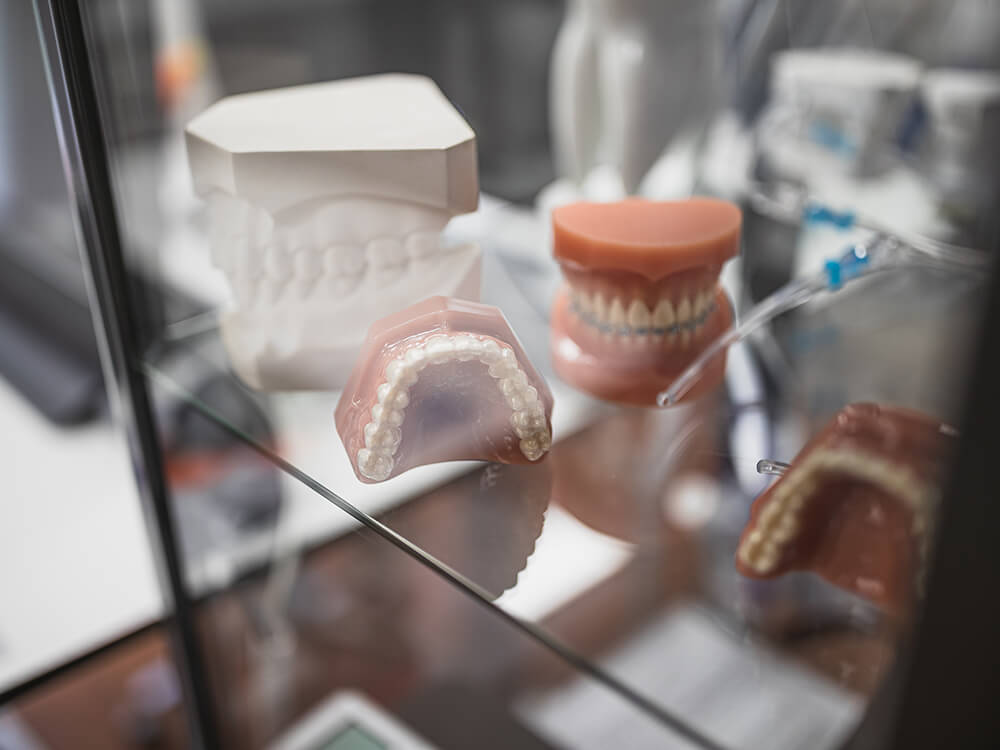
A misaligned tooth (crooked teeth) is any position of one or more teeth outside the ideal dental arch shape of the upper or lower jaw.
In addition to aesthetic problems, misaligned or crooked teeth can also cause malfunctioning of the dentition, which can sometimes lead to pain in the long term.
Causes of misaligned teeth
- Congenital causes: Cleft lip and palate.
- Hereditary skeletal causes: upper or lower jaw that is too large or too small (progenia, pseudoprogenia, distal bite (backbite). Open or deep vertical relations, incompetent lip closure, overbite.
- Disproportion between tooth and jaw size: crowding, gaps in the dental arches.
- Shifting, transposition and retention of teeth.
- Hormonal: Pituitary dwarfism, hypothyroidism.
- Tooth malformation: Aplasia, hypoplasia, hyperplasia.
- Premature loss of milk teeth.
- Bottle feeding.
- Habits: Finger sucking, sucking, lip biting, swallowing abnormalities, mouth breathing. Accidents.
- Muscular dysfunction: Tongue dysfunction, chewing muscle dysfunction.
Consequences of misaligned teeth
- Malfunction of the temporomandibular joints and masticatory muscles.
- Functional disorders (chewing)
- Temporomandibular joint complaints.
- Breathing problems (mouth breathing).
- Sleep disturbance (snoring).
- Speech defects (lisp).
- Increased risk of tooth decay.
- Increased risk of periodontitis.
- Malformation of the teeth.
- Tooth eruption disorder.
- Incompetent lip closure.
- Abrasion of the teeth and temporomandibular joints due to grinding.
- Increased risk of infection (due to mouth breathing).
- Cervical spine syndrome and imbalance of the body holding apparatus
- Tinnitus and earache.
- Impairment of jaw growth.
Possible therapies for misaligned / crooked teeth
There are many forms of therapy that are used in orthodontic practice. Which treatment promises the greatest success must be decided individually depending on the initial situation. In the following, we would like to present the techniques that we offer you in our practice.
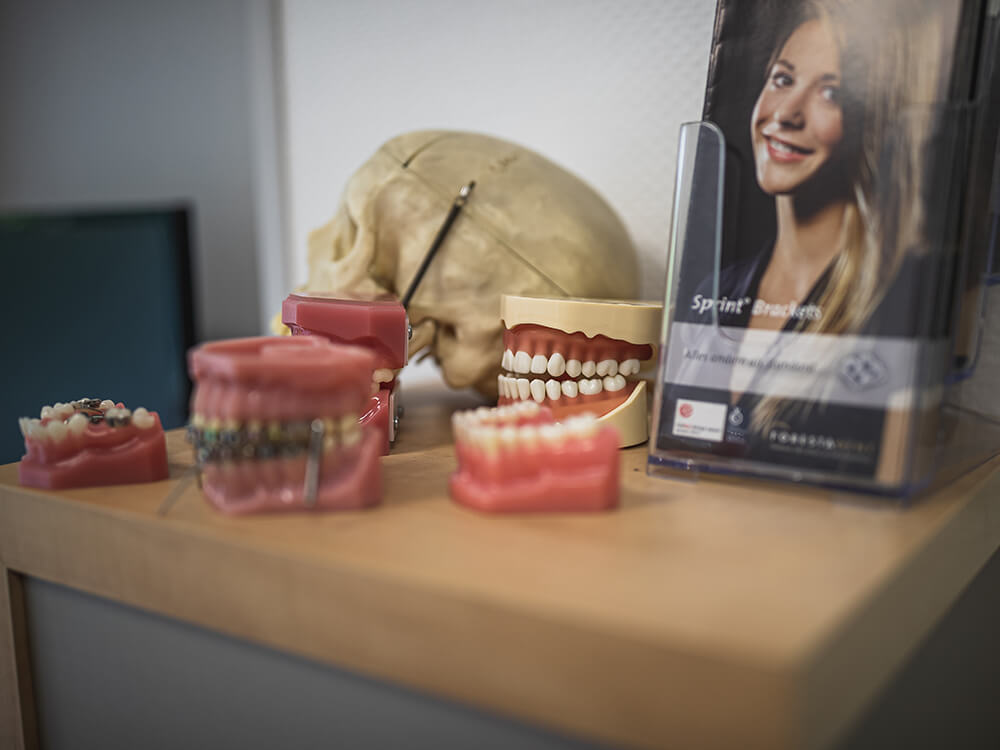
Jaw misalignments
Correction of overbite, underbite or crossbite
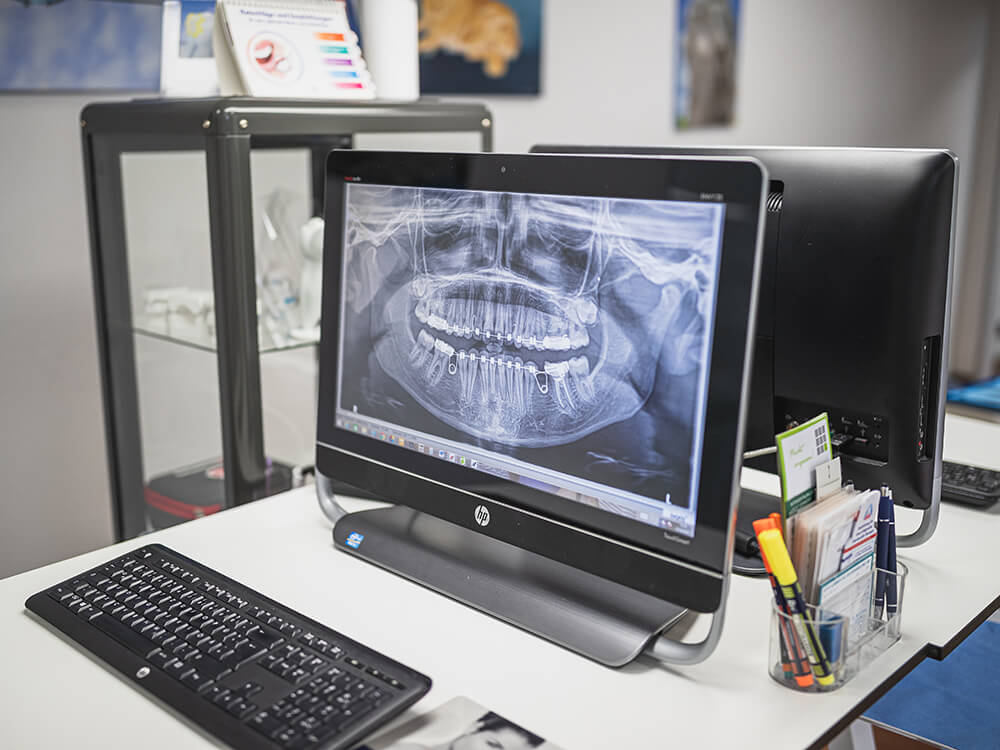
A skeletal malocclusion in the jaw area manifests itself, for example, as underdevelopment, retraction or protrusion of the jaw – depending on which malocclusion is present, this is also referred to as an overbite, underbite or crossbite.
As with misaligned teeth, conventional fixed and removable braces can also be used for skeletal misalignment of the jaw.
If there is a jaw misalignment, i.e. a skeletal anomaly, this is usually corrected in adolescents by controlling growth with the help of removable appliances.
Possible forms of therapy for misaligned jaws are
Stopping bad habits in the children, e.g. finger and thumb sucking, lisping, ...
We can help your child to break bad habits quickly and stress-free with the help of appropriate tools, tips and tricks. We will treat your child's speech defects in co-operation with a speech therapist.
Early orthodontic treatment for infants.
Misaligned teeth in small children can lead to maldevelopment of the jawbone and dentition. We use appropriate removable and fixed appliances to correct the acute misalignment in a short period of time.
Treatment of malocclusions in children and adolescents.
As a rule, a removable appliance is sufficient to correct jaw misalignment in children and adolescents (functional orthodontic appliances called FKO appliances). Subsequently, fine corrections are carried out with a fixed appliance (called Multi Bracket System, MB).
Treatment of malocclusions in adults
This requires a combined orthodontic-orthognathic-surgical concept.
Treatment of malocclusions in children and adults.
The misalignment of permanent teeth can be corrected at any age (even in old age). Fixed, removable, visible and invisible appliances can be used for this purpose. MB appliance (in the visible area), lingual technique (invisible), aligner technique (almost invisible), skeletal anchorage and segment technique.
Treatment of temporomandibular joint disorders (craniomandibular dysfunctions CMD).
Misaligned teeth are very often the cause of TMJ problems. Firstly, a bite splint is used to ensure that the temporomandibular joints are free of pain. As a rule, we consult a physiotherapeutic accompanying treatment to accelerate the recovery of the diseased joint structures. The malocclusion can then be corrected.
Lingual technique
Gentle correction of crooked teeth
With this technique, the brackets and arches are attached to the lingual surface (inside) of the teeth. The advantage of this technique is that the braces remain invisible during the entire treatment, although all tooth movements can be carried out, similar to conventional fixed braces.
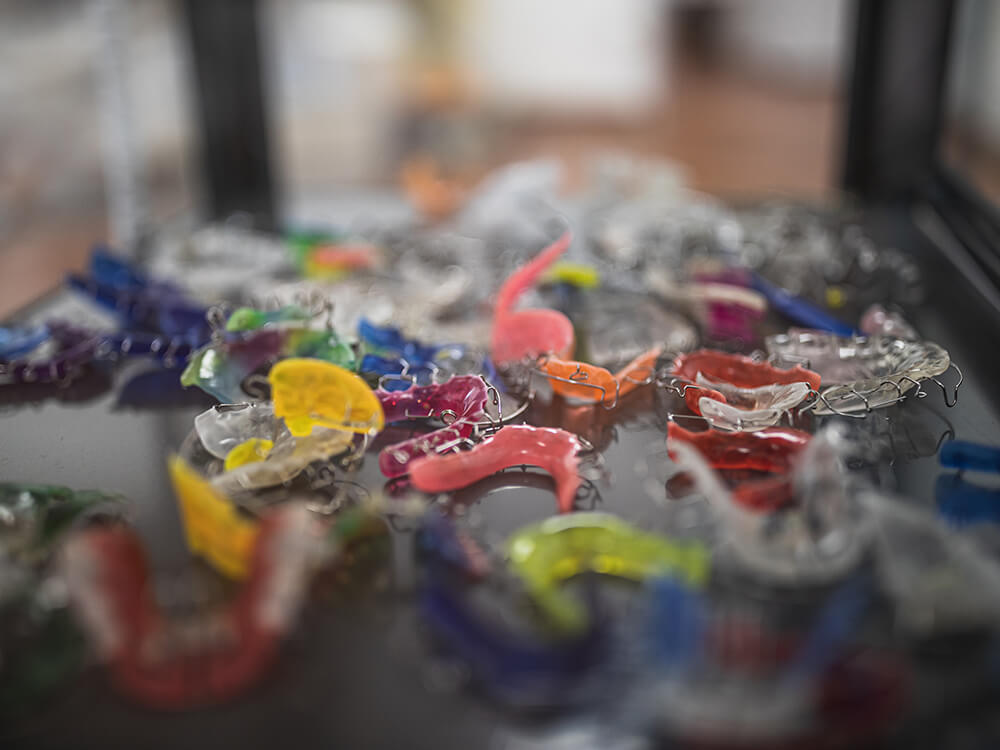
As a rule, the tongue gets used to the internally attached appliances after a few weeks. The lingual technique requires a complex laboratory procedure, which results in higher treatment costs.
Brackets
Lingual brackets
The conventionally manufactured lingual brackets are adapted to the tooth surface with a plastic base and customised. The customisation of the bracket base restricts the tongue space. This makes it more difficult for the tongue to get used to the new situation.
Incognito brackets
The development of Incognito brackets has largely solved the problem of acclimatisation of the tongue. Incognito brackets are individually and very precisely manufactured from a gold alloy using state-of-the-art technology. They have a very wide base surface and flat bracket bodies so that the tongue can quickly familiarise itself with them.
Take a look at the examples to see the results of our tooth correction with the lingual technique for yourself.
Aligner technique
Invisible braces for correcting teeth
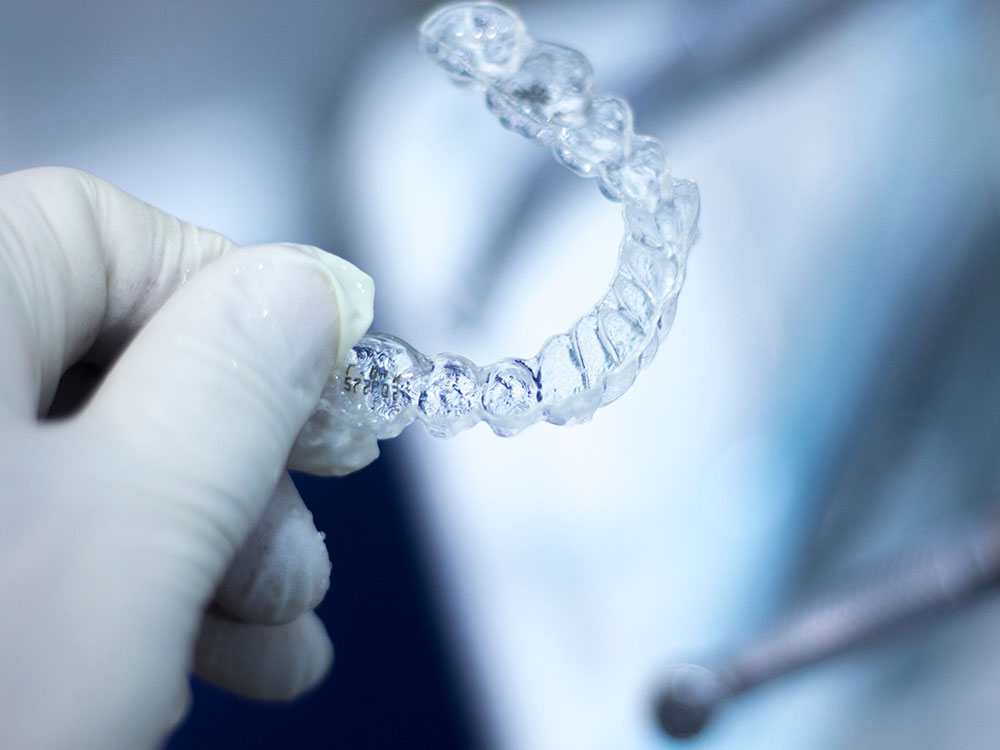
In the aligner procedure, teeth are corrected with the help of transparent, elastic splints (so-called aligners). Here, 3D computer technology is used to produce a whole series of aligners from very precise two-phase silicone impressions of the teeth. The individual aligner splints are then worn in a predetermined sequence, thereby realising the desired tooth correction. They are very comfortable and almost invisible. During this type of orthodontic treatment, optimal oral hygiene is easily possible as the aligners can be removed for eating and brushing teeth.
Adults in particular appreciate aligners, as they can easily remove the aligners for professional meetings, for example.
Take a look at the examples to see the results of our tooth correction with the aligner technique for yourself.
Case-1
A 64-year-old female patient with crowding in the front of the lower jaw
Case-2
In this 35-year-old woman, tooth 12 was a peg tooth and tooth 22 was not attached. This had resulted in a medial diastema. By using the aligner technique, the medial diastema was closed and the gap in region 22 was opened for an implant restoration.
Case-3
Gap closure in the anterior maxilla (medial diastema) in a 28-year-old female patient.
Skeletal anchoring
Multibracket system for tooth correction
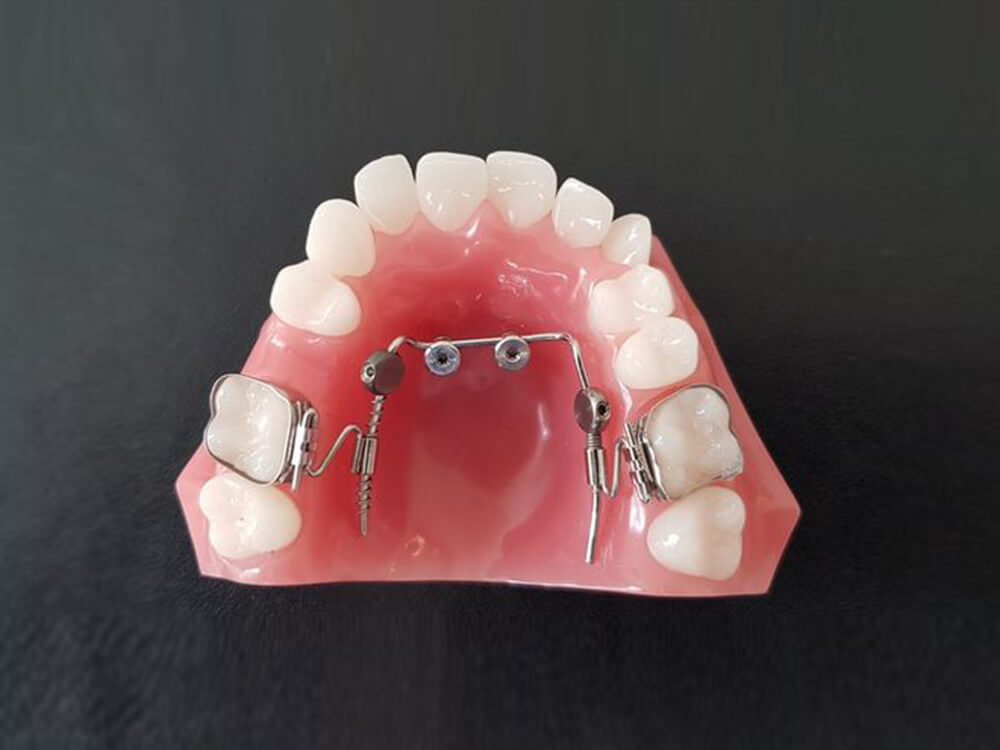
The combination of skeletal anchorage and multi-bracket systems is ideally suited for difficult tooth corrections, especially in the posterior region.
With conventional methods, the entire dental arch must be fitted with brackets to anchor the teeth in the posterior region.
With the help of skeletal anchorage, this is no longer necessary. Brackets are only bonded to the teeth to be moved. We use orthodontic anchoring implants, pins (mini screws) and Ortho-Bone-Anchor elements (OBA) for skeletal anchoring.
Take a look at the examples to see the results of our tooth correction with skeletal anchorage for yourself.
Case-1
In this case, some teeth 18, 17, 25, 27, 28, 38, 37, 47 and 48 were displaced and impacted.
Case-2
Tooth 26 had to be extracted from a 16-year-old boy.
Case-3
Shifting of the entire dental arch (distalisation) in the upper jaw with the aid of a palatal implant and lingual technique in a 17-year-old patient.
Functional orthodontics
Functional orthodontic appliance
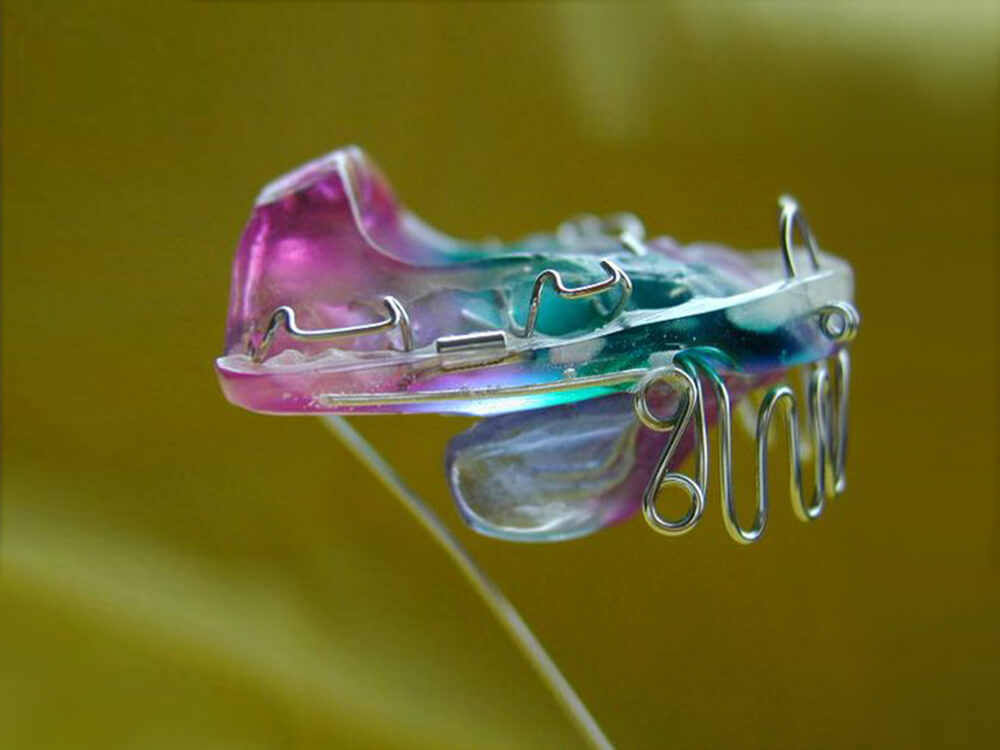
Misaligned jaws in adolescents are usually corrected with the help of a removable functional orthodontic appliance.
The idea of functional orthodontic therapy emerged at the beginning of the 20th century and led to the development of various appliances whose main task is to reorganise the soft tissue and correct jaw misalignment.
These appliances have one thing in common: the body's own muscle forces are used to influence the growth of the jaws and optimise the position of the two jaws in relation to each other.
Example of treatment procedure
Correction of the mandibular deviation in an adolescent with the aid of a functional orthodontic appliance.
Take a look at the example to see the results of our jaw correction with functional orthodontics for yourself.
Orthognathic surgery
Oral surgery and orthodontics
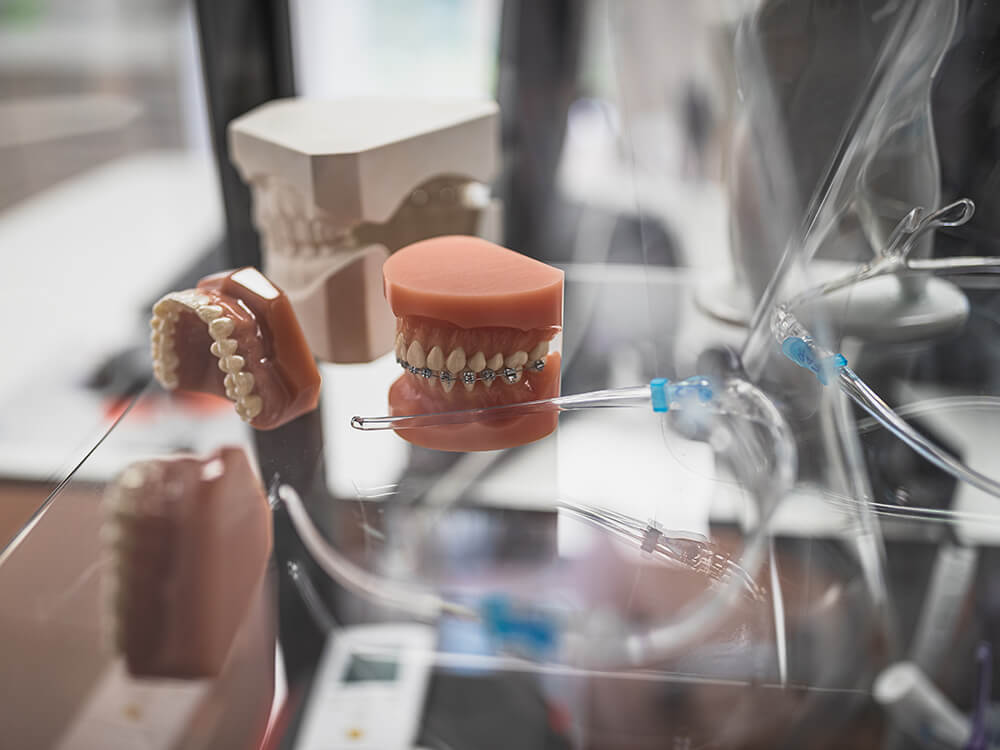
A combination of oral surgery and orthodontic measures is required to correct malocclusion in an adult.
In such cases, the skeletal jaw bases are surgically brought into an optimal relationship to each other, while the rows of teeth of the two jaws are adapted to each other through orthodontic measures.
This therapy concept requires close co-operation between the orthodontist and the oral surgeon.
Take a look at the examples to see the results of our jaw correction with orthognathic surgery for yourself.
Case-1
Correction of underdevelopment of the upper jaw by advancement of the upper jaw using a distractor and subsequent surgical repositioning.
Case-2
The treatment of the skeletal open bite was also treated by a combined orthodontic-jaw surgery procedure.
Case-3
Surgical correction of mandibular advancement in an adult patient.
Orthodontics for adults
Comfortable and effective treatments
Modern technical developments in dentistry enable us to offer our patients better, more comfortable, more effective and, above all, invisible treatments.
These techniques have been developed primarily for adult patients, but can be used just as well for young patients.
Thanks to these modern treatment methods, more and more adult patients are fulfilling their desire for a more beautiful smile.
There are various reasons why adults have so far refused orthodontic treatment:
- Many adults are unaware of these diverse treatment options. They believe that orthodontics is only possible for adolescents.
- In fact, orthodontic treatment is possible and sensible well into old age.
- While braces are considered normal for children and adolescents, adults can only accept them to a limited extent. The use of visible appliances is associated with considerable professional, social and aesthetic restrictions.
Treatment options
Treatments in our practice are particularly suitable for adults:
- Lingual technique
- Aligner technique
- Segment technology
